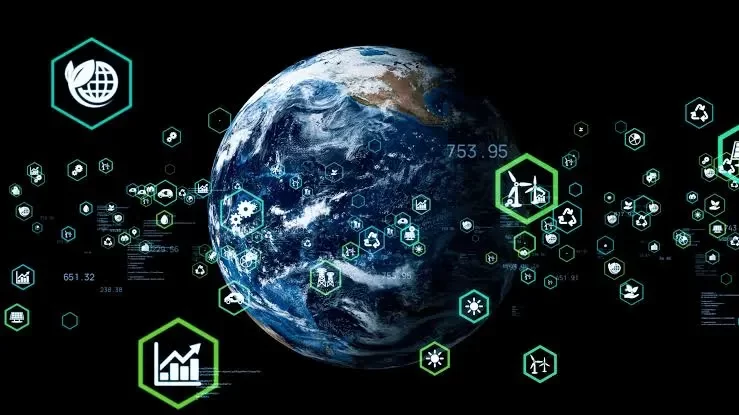
Global warming is one of the most pressing environmental issues that are currently being discussed. Crop yields, weather patterns, sea levels, wildfires, and ecological systems are all impacted by our warming climate. Data science plays a crucial role in trying to improve the situation.
Since records began to be kept in the 1850s, global temperatures have increased at a rate that has never been seen before.

By the end of this century, temperatures are expected to rise another 1.8 to 5.8 °C. The release of greenhouse gases like carbon dioxide, methane, water vapor, chlorofluorocarbons, and nitrous oxide contributes to global warming.
These gases significantly affect the environment which makes the climate trap heat and warm the earth. Factory farming, car exhaust, airplane exhaust, and the extraction of fossil fuels all produce a significant amount of these gases.
Sea levels will continue to rise, and crop yields (food production) will decrease. And ecosystems will continue to be disrupted if we don’t act quickly on climate change. Crop weeds, insects, and pest infestations are anticipated to rise in relation to food production as a result of the warming climate.
Given the future ramifications of environmental change on food creation and infection spread, government-funded instruction on the effects of environmental change is essential.
We will conduct a straightforward exploratory analysis of public data on climate change from datahub and global crop yield data from ourworldindata.org in this post. In another post, we will investigate some irresistible illness information.

At this point, it would be necessary to conduct a more in-depth analysis before drawing any conclusions from the data, but our analysis appears to be in line with what has been published in the literature. We will conclude our investigation here, but you are welcome to examine crop yields in other regions and other climate change data on datahub.
As previously stated, scientists believe that climate change is influencing the spread of infectious diseases in addition to affecting crop yields. We will examine publicly available data on climate change and infectious diseases in the following post to see if any patterns emerge.
Although scientists prefer to use the term “climate change” to describe the complex shifts currently affecting our planet’s weather and climate systems, many people consider global warming and climate change to be synonymous terms.

Extreme weather events, shifting wildlife populations and habitats, rising sea levels, and a variety of other effects are all part of climate change. As humans keep adding greenhouse gases that trap heat to the atmosphere, all of these changes are starting to appear.
These effects of climate change have been documented by scientists already:
• Ice is melting everywhere, especially at the poles of the Earth. Mountain glaciers, ice sheets that cover Greenland and West Antarctica, and Arctic sea ice are all examples of this. There are now fewer than 30 glaciers in Montana’s Glacier National Park, down from 150 in 1910.
• Sea-level rise is exacerbated in large part by this melting ice. Every year, sea levels rise by 0.13 inches (3.2 millimeters) around the world. In recent years, the rate of rise has accelerated, and it is anticipated that it will continue to do so in the coming decades.
• Wildlife and their habitats are being affected by rising temperatures. In Antarctica, species like the Adélie penguin have been challenged by disappearing ice. Some populations on the western peninsula have collapsed by 90% or more.

• Numerous species are migrating in response to rising temperatures. Some alpine plants, foxes, and butterflies have moved north or to higher, cooler places.
both rain and snow—has increased worldwide. However, some areas are experiencing more severe drought, which raises the possibility of wildfires, crop losses, and water scarcity.
• Some species, such as crop pests, mosquitoes, ticks, jellyfish, and others, are doing well. Millions of acres of forest in the United States have been destroyed by growing populations of bark beetles, which feed on spruce and pine trees. Other effects could occur later this century if warming continues.
These are some:
Climate change research is one fascinating example of how data science is making the world a better place to live. An in-depth look at how massive amounts of data can be utilized and analyzed to generate viable solutions to the threat posed by climate change is provided by a recent NASA Technical Reports Server (NTRS) study.
Climate science, according to the report, is a big data field that is expanding at an unprecedented rate. The difficulty lies in gaining a deeper comprehension of the repercussions of these vast datasets and putting in place the appropriate computational resources to develop and implement useful applications.

For instance, the report states that efficient and effective methods must be provided for publishing large-scale scientific data collections and carrying out scientific analyses based on large amounts of data. The goal of data science is to assist in the conversion of large collections of scientific data into useful knowledge. This can be used by businesses to develop real solutions to the problem of climate change.
Data science is providing practical solutions to the problem of climate change in additional ways, according to a recent Forbes article.
Utilizing sensors in their environments to track carbon emissions, for instance, can help businesses reduce their carbon footprint. Utilizing IoT sensors to track energy and waste; and utilizing unstructured, raw data analysis to produce intelligence that can be used in renewable resources like wind turbines.

Better climate data science is driven by the rapid growth of artificial intelligence and machine learning technologies in modern data science. AI is one of a kind in that it can find patterns in huge amounts of data more quickly than humans can. This can then be used by data scientists to identify feasible solutions to numerous common issues.
IDC predicts that investments in AI and analytics will reach $185 billion this year, growing at a 12% compound annual growth rate (CAGR) through 2024. In point of fact, AI and machine learning enjoy such widespread popularity in the field of data science that the two terms are now practically synonymous with data science.
Indeed found that the terms “AI” and “machine learning” were mentioned in the job descriptions of 75% of data science positions. In the meantime, interest in laborers with computer-based intelligence abilities has dramatically increased over the most recent three years.
In order to become successful data scientists and secure top positions, aspirant data scientists are increasing. And data scientists rely on AI tools and programming languages like Python, which is the most widely used AI and machine learning language.
Understanding important data science processes like data wrangling, exploration, visualization, hypothesis building, and testing require Data Science with Python training.
Several studies can benefit greatly from AI. Every sector, from climate change to technological advancements, has benefited greatly from the growing field of data science.
Data science and artificial intelligence need to work in the climate sector as well because the climate needs to change. If you want to pursue your career in the field of data science, you can opt for advance data science courses.
We provide online certification in Data Science and AI, Digital Marketing, Data Analytics with a job guarantee program. For more information, contact us today!
Courses
1stepGrow
Terms
Anaconda | Jupyter Notebook | Git & GitHub (Version Control Systems) | Python Programming Language | R Programming Langauage | Linear Algebra & Statistics | ANOVA | Hypothesis Testing | Machine Learning | Data Cleaning | Data Wrangling | Feature Engineering | Exploratory Data Analytics (EDA) | ML Algorithms | Linear Regression | Logistic Regression | Decision Tree | Random Forest | Bagging & Boosting | PCA | SVM | Time Series Analysis | Natural Language Processing (NLP) | NLTK | Deep Learning | Neural Networks | Computer Vision | Reinforcement Learning | ANN | CNN | RNN | LSTM | Facebook Prophet | SQL | MongoDB | Advance Excel for Data Science | BI Tools | Tableau | Power BI | Big Data | Hadoop | Apache Spark | Azure Datalake | Cloud Deployment | AWS | GCP | AGILE & SCRUM | Data Science Capstone Projects | ML Capstone Projects | AI Capstone Projects | Domain Training | Business Analytics
WordPress | Elementor | On-Page SEO | Off-Page SEO | Technical SEO | Content SEO | SEM | PPC | Social Media Marketing | Email Marketing | Inbound Marketing | Web Analytics | Facebook Marketing | Mobile App Marketing | Content Marketing | YouTube Marketing | Google My Business (GMB) | CRM | Affiliate Marketing | Influencer Marketing | WordPress Website Development | AI in Digital Marketing | Portfolio Creation for Digital Marketing profile | Digital Marketing Capstone Projects
Jupyter Notebook | Git & GitHub | Python | Linear Algebra & Statistics | ANOVA | Hypothesis Testing | Machine Learning | Data Cleaning | Data Wrangling | Feature Engineering | Exploratory Data Analytics (EDA) | ML Algorithms | Linear Regression | Logistic Regression | Decision Tree | Random Forest | Bagging & Boosting | PCA | SVM | Time Series Analysis | Natural Language Processing (NLP) | NLTK | SQL | MongoDB | Advance Excel for Data Science | Alteryx | BI Tools | Tableau | Power BI | Big Data | Hadoop | Apache Spark | Azure Datalake | Cloud Deployment | AWS | GCP | AGILE & SCRUM | Data Analytics Capstone Projects
Bangalore:
Anjanapura | Arekere | Basavanagudi | Basaveshwara Nagar | Begur | Bellandur | Bommanahalli | Bommasandra | BTM Layout | CV Raman Nagar | Electronic City | Girinagar | Gottigere | Hebbal | Hoodi | HSR Layout | Hulimavu | Indira Nagar | Jalahalli | Jayanagar | J. P. Nagar | Kamakshipalya | Kalyan Nagar | Kammanahalli | Kengeri | Koramangala | Kothnur | Krishnarajapuram | Kumaraswamy Layout | Lingarajapuram | Mahadevapura | Mahalakshmi Layout | Malleshwaram | Marathahalli | Mathikere | Nagarbhavi | Nandini Layout | Nayandahalli | Padmanabhanagar | Peenya | Pete Area | Rajaji Nagar | Rajarajeshwari Nagar | Ramamurthy Nagar | R. T. Nagar | Sadashivanagar | Seshadripuram | Shivajinagar | Ulsoor | Uttarahalli | Varthur | Vasanth Nagar | Vidyaranyapura | Vijayanagar | White Field | Yelahanka | Yeshwanthpur
Other Top Cities:
Mumbai | Pune | Nagpur | Delhi | Gurugram | Chennai | Hyderabad | Coimbatore | Bhubaneswar | Kolkata | Indore | Jaipur and More